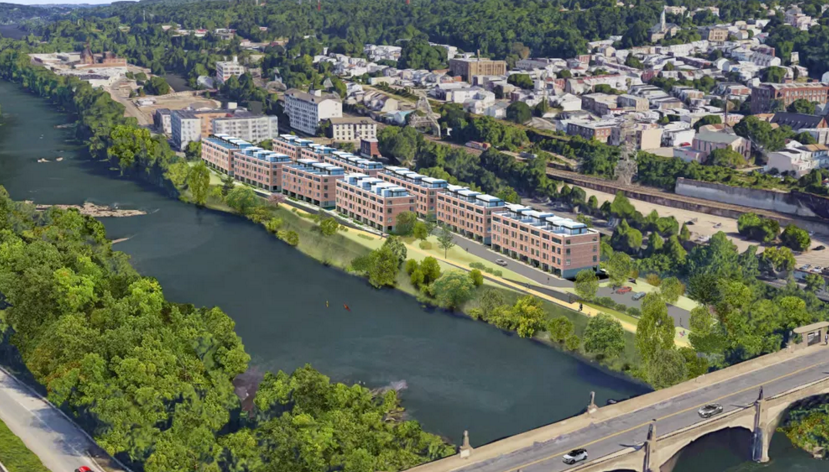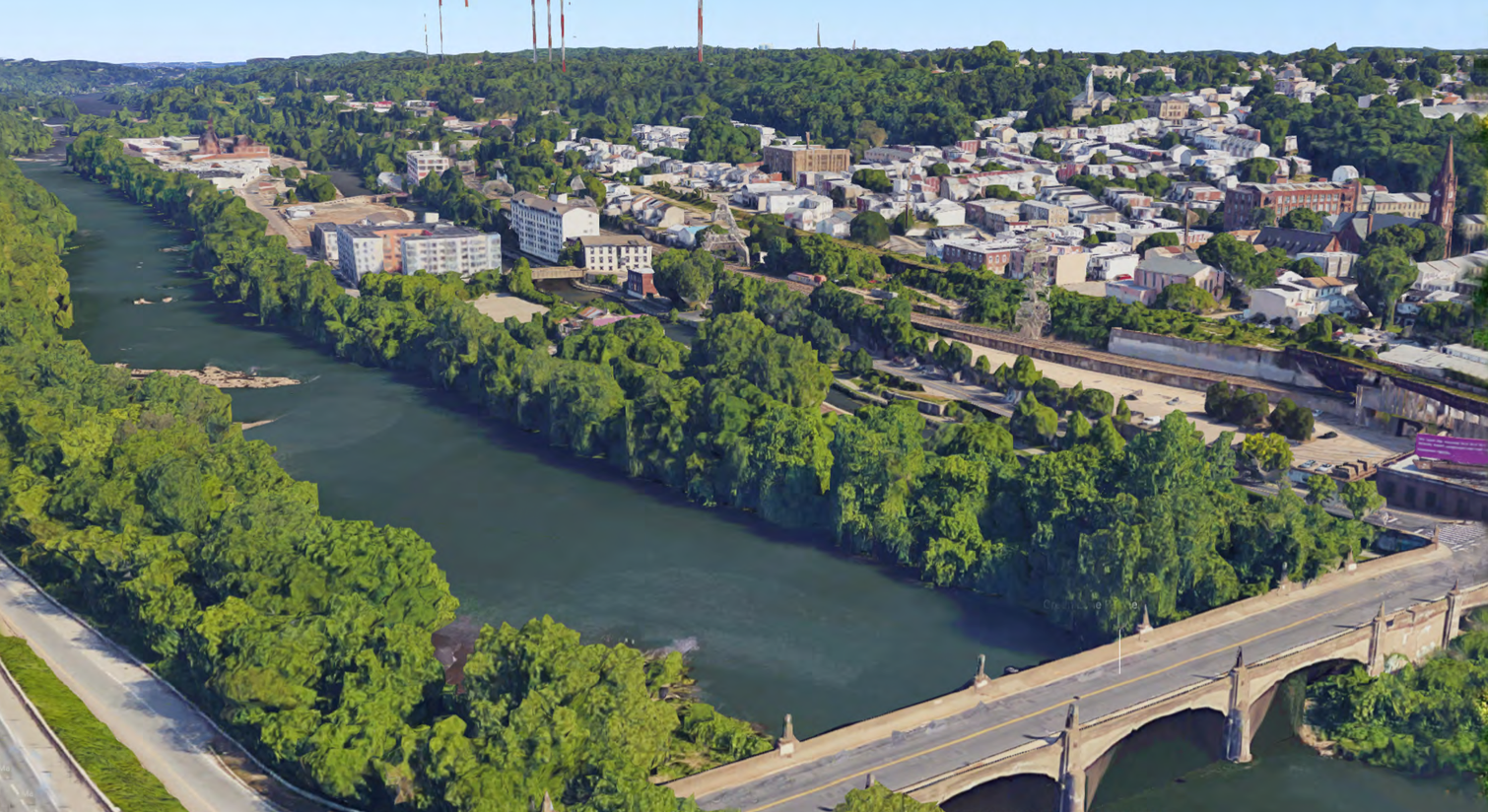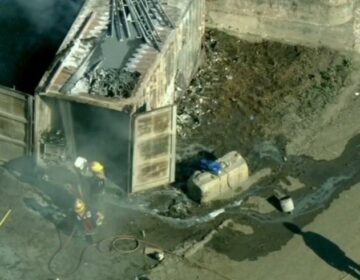Lux townhouses are coming to a flood-prone island off the coast of Manayunk

City Council has given the green light on a contested rezoning that will allow residential development in a floodplain nestled between the Schuylkill River and the Manayunk Canal on Venice Island.
The council voted unanimously on Thursday to approve the zoning tweak, which will allow 68 luxury townhouses and 128 parking spaces to rise on the waterfront site, now a tangle of overgrown brush and weeds. Given the unanimous support, the mayor is likely to sign the bill without any delay, allowing construction to proceed.
Owned by Manayunk developer Dan Neducsin, the formerly industrial site’s residential transformation has been in the works for over a decade. Blocking them until now were neighbors concerned about the environmental impacts of putting housing on the flood-prone spit of land separated from Manayunk’s Main Street by the thin ribbon of the canal.
“We’ve always considered it really wrong to put residential next to the river like that, but that battle is lost,” says Kevin Smith, president of the Manayunk Neighborhood Council, which had previously fought the residential development of Venice Island. In the end, after fighting all the way to the state Supreme Court, they lost, and two residential complexes subsequently rose on the island. “Given the actual conditions [in the area], this seems far better than anything ever proposed down there in the past 20 years.”
The rezoning approved on Thursday creates a “master plan” for the site to allow for more parking spaces, and exempt it from the Manayunk Historic District. (There are no historic buildings on the site.) Earlier site development proposals shot down by neighbors called for more dense development, with hundreds of residential units rather than dozens.
“We really believe this will be highest and best use and provide the most benefits to community,” said Greg Hill, founder of D3 Developers in a Jan. 16 presentation to the Philadelphia City Planning Commission. D3, a local firm that has done other modern townhouse projects in South Kensington, Fishtown and Fairmount, is partnering with a Maryland developer to build out the site.

Hill’s presentation may have sold Manayunk Councilman Curtis Jones but it fell short of convincing the Planning Commission.The appointed board voted unanimously to not recommend the enabling legislation, a position the agency’s staff of expert planners endorsed.
Venice Island is in the 100-year floodplain, which means there is a one percent chance it will flood every year. Until about ten years ago, when another developer challenged the maps to develop on this site, it was in the floodway—the portion of the floodplain that carries the fastest moving and deepest water. (In 2014 a nearby development that is still in the floodway, Venice Lofts, flooded and the fire department had to rescue residents with motorized boats.)
“The problem is if there is a 100-year flood here, they are on island,” said Marty Gregorski, the director of the Planning Commission’s development division during a presentation at the Jan. 16 meeting. “And Manayunk’s Main Street floods too, so there are some life safety concerns about how people will get out…In this case, the staff recommendation is not for approval due to possible life safety concerns.”
The project only has one point of egress onto the mainland, Leverington Avenue, which leads to flood- prone Main Street. D3 declined to grant PlanPhilly an interview for this story, but at the Planning Commission, a representative of the developer stated that the company plans to build a footbridge across the canal to allow another point of egress and another bridge connecting their project to Green Lane to the south. To mitigate the flood risk, the developer proposes to layer 10 feet of compacted soil over the entire site, lifting their buildings out of the floodplain. On the ground floor they will place parking, which they say would lessen dangers to life and limb in the event of a flood.
“The concept of developing residential on Venice Island is not new,” said Hill of D3 at the January Planning Commission meeting. “There are multifamily projects to the south on either side of Green Lane, and both of those are on lower elevations than we are and neither raised the grading. So we feel like we are taking some extraordinary measures here to improve site safety.”
District Councilman Curtis Jones, who introduced the rezoning legislation, says that the city is prepared to respond if a flood does wash in.
“Every 10 years, there is a 100-year flood, I’ve experienced at least four of them,” said Councilman Jones, asked about the Venice Island development on the floor of City Council at a January meeting. “We have become pretty adept in that area with dealing with it. We’ve developed good communications systems with emergency management, the fire department, and the police to be on pins and needles when we hear about these forecasts. I am confident that we will build in proper measures to get on and off that island.”
But environmental activists interviewed for this article warned that these protections are often insufficient. A much surer way to save lives is to avoid building on a floodplain site that is surrounded by water.
The executive director of Green Building United, Alex Dews, argues that the rezoning illuminates that Philadelphia lacks resiliency guidelines for development in areas that could be directly affected by climate change.
“It’s really important that we aren’t doing this on a project-by-project basis, with no clear guidelines,” says Dews. “Just since 2010 Philly has had so much more extreme weather than had been observed in the previous century. We know it is going to get more extreme and, in this part of the city, the flooding is only going to get worse. So a close look at the climate data should really be part of this.”

People have inhabited Venice Island for generations. But throughout the 19th and much of the 20th centuries, most of the buildings were designed for industrial use, largely for Philadelphia’s thriving textile concerns and housing for their workers.
Then in 1999, Michael Nutter, then a Councilman, introduced legislation to rezone the area for residential development, clearing the way for the two apartment buildings now on the island. At that time, Manayunk was one of the few corners of Philadelphia that was attracting investment and the impulse to maximize available land was an understandable one. But that same year, Hurricane Floyd caused the Schuylkill River to rise to 14.1 feet, swamping much of the island.
The Planning Commission is an advisory body and its seal of approval was not needed for the project to move forward.
Gregorski says the agency is trying to do what it can do to discourage housing from being built in areas like Venice Island that are vulnerable to flooding.
“Some of the other properties were built years ago, but now we are really trying to look again at how we manage our floodplain now,” says Gregorski. “It’s our belief that the floodplain will expand as sea level rises, so we are starting to look at some of these areas and zone them for something other than solely residential.”
WHYY is your source for fact-based, in-depth journalism and information. As a nonprofit organization, we rely on financial support from readers like you. Please give today.





